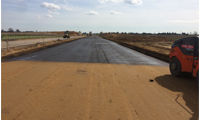

A cement supplier has suggested that wider adoption of soil stabilisation could make road construction more cost-effective and sustainable.
In October’s Budget, the Chancellor pledged £25 billion over the next five years for the second phase of the Road Investment Strategy to continue long-term improvements to Britain’s motorways and major roads. One of the core objectives of the strategy is to create a ‘greener network’ and bring down maintenance costs, calling on Highways England and its supply chain partners to step up to the challenge through innovation and creativity.
According to Lafarge Cement, part of Aggregate Industries, one of the ways the industry can achieve this is by using hydraulic road binders to improve weak in-situ materials for foundations in road engineering.
Steve Curley, Commercial Director at Lafarge Cement, said that in the future, this will become “the go-to method for greener, leaner and more efficient road construction.”
He said: “As we move on to the planning and implementation of the Road Investment Strategy 2, the key to successfully building a world-class sustainable road network will be taking a holistic ‘ground up’ approach to innovative ways of working.
“This often starts with ground engineering, where for years the issue of weak in-situ materials has been solved by replacing them with imported natural aggregates – a costly method.
“More recently, soil stabilisation that blends in-situ materials with a rapidly hardening hydraulic road binder has been proven to remove the need for traditional sub base or base course aggregate, making it more environmentally friendly as it cuts down on material waste and the carbon emissions associated with hauling aggregates.”